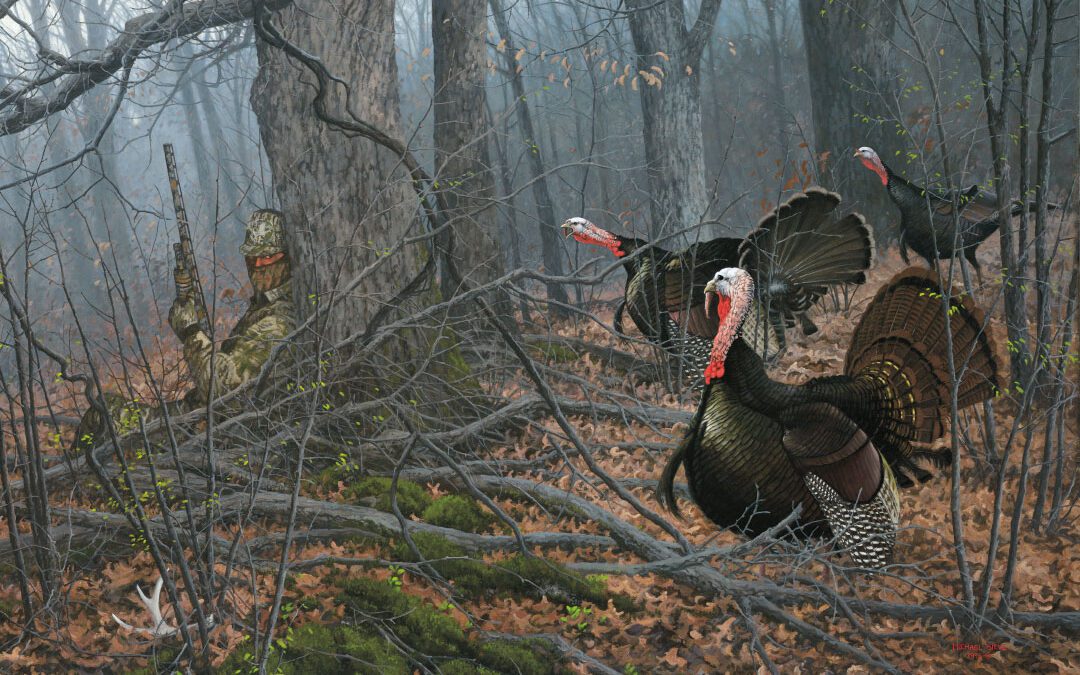Aficionados of campfire poetry in general, or fans of the so-called “Poet of the Yukon,” Robert Service, will likely recognize that the title of this piece comes from his eerie yet wonderful poem, “The Cremation of Sam McGee.” The setting for the saga lies far from wild turkey habitat, although old Sam, the focus of the poem, did hail “from Peachtree, down in Tennessee.” That’s squarely in gobbler territory. My real point though is that anyone who does a great deal of turkey hunting over an extended period of years is going to experience some “strange things”—wacky, delightful, possibly downright dangerous, but unquestionably memorable. Such has certainly been my lot, and there’s every likelihood some of the scenarios described here will bring to mind strange sagas of your own.
Feathered Fisticuffs
A couple of decades ago, during an annual jaunt to Georgia’s The Lodge at Cabin Bluff where I told turkey tales, provided a bit of basic instruction to a group of physicians combining hunting with professional seminars and did some guiding, it was my privilege to witness an epic struggle between a man and a gobbler. The physician accompanying me was a delightful fellow with whom I had successfully hunted before, and he had always seemed the steely, focused sort of individual possessed of all the patience and persistence required to deal with gobblers.
Accordingly, when we tucked into a huge brush pile in the middle of a cutover well before fly-down time, and knowing from prior scouting there were birds aplenty in the area, I gave way to a moment of what folks where I grew up used to call a “case of the big britches.” Since I had a license and was carrying my shotgun, it seemed possible we might double on gobblers. Optimism in that regard increased when at least four birds scattered around the clear cut began to declare their dominion to everyone within earshot. I whispered to my companion, “If you shoot one don’t run to it. Sit tight and maybe we can call in a second bird.”
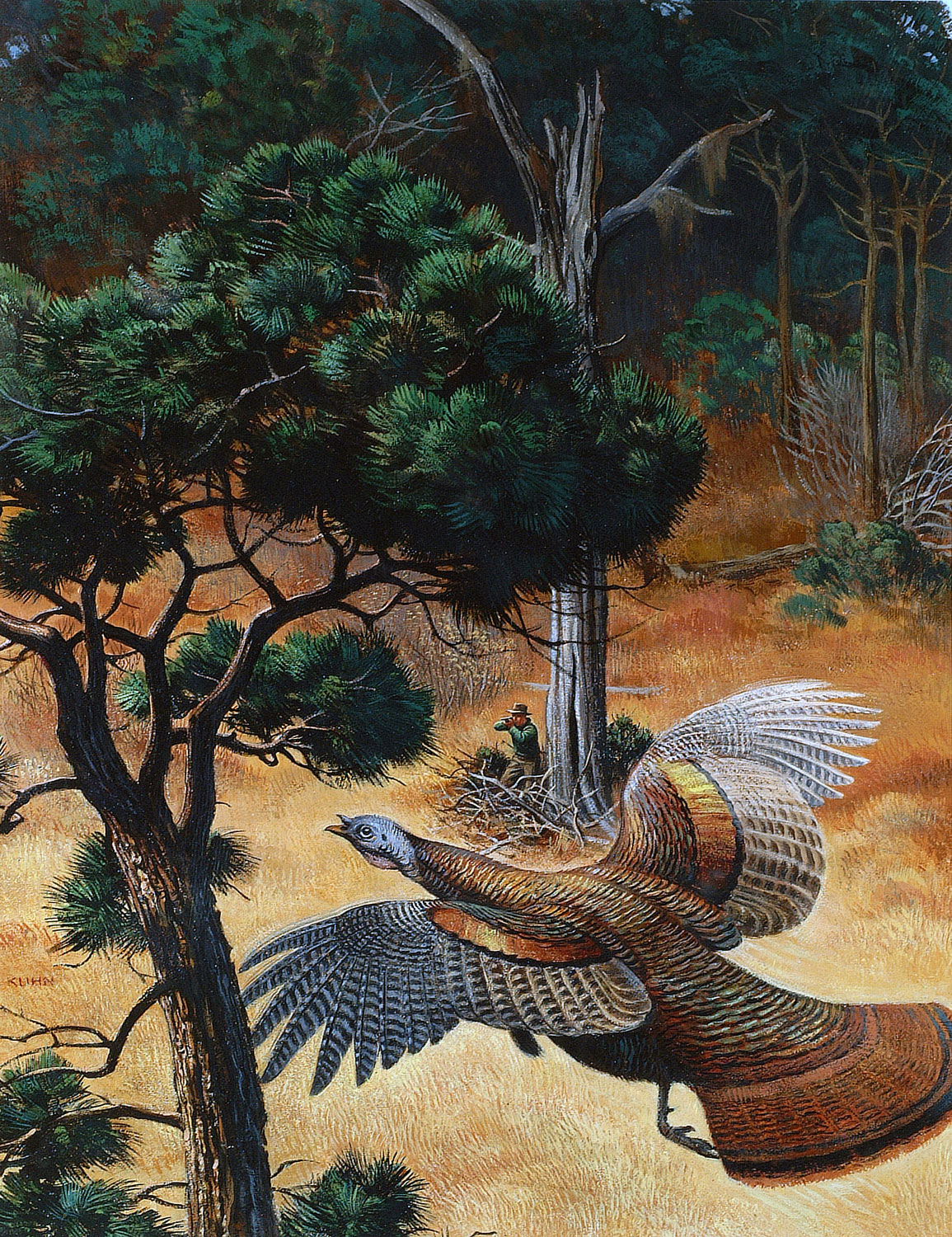
Wild Turkeys by Bob Kuhn.
All initially went according to plan, although the decidedly slow progress of a gobbler responding to my wingbone yelps, not to mention the fact the bird was visible for a full 400 yards as he slowly made his way to us, was nerve-wracking. When within 35 to 40 yards, the wary bearded wonder sensed something was amiss and sort of popped or shrugged his wings in a fashion that all too clearly conveyed the message—“I just remembered I have an urgent appointment in the next county.”
“Shoot now,” I whispered, and the good doctor, who had somehow managed to hold his gun more or less steady for an inordinately long time, did just that. The gobbler flopped with the shot and the hunter immediately forgot everything I had said about staying in place. He broke for the bird with alacrity and momentarily the most awful man vs. turkey fight imaginable broke out. He grabbed the turkey but somehow the struggling bird got on top of him, flogging with such intensity that when it was all over the turkey had precisely one tail feather remaining intact and the ground for several yards in all directions was littered with feathers from the purt nigh plucked bird.
Once I recovered from laughing sufficiently to make my way to the immediate scene, things were at something approaching a standoff. The hunter had a death grip on one of the turkey’s legs and his neck, while the other leg churned away like a piston on an old-time steam locomotive. If it is possible for a wild turkey to produce a look of pure, unadulterated hatred, that was what I saw. I ended the struggle by driving the point of my sheath knife into the gobbler’s brain and then both of us laughed uncontrollably as we surveyed the scene, assessed the state of clothing shredded by the bird’s spurs, and tagged the turkey.
Ten days later, unexpectedly, an X-ray arrived in the mail. It showed the neck of the gobbler and a single shotgun pellet which had just nicked a vertebrae. Had the good doctor not forgotten my directions about staying put, the gobbler would soon have regained consciousness and escaped. As it was, I was privileged to have a front row seat in an epic man vs. gobbler bout.
Snaky Stuff
Spring turkey season comes during earth’s reawakening and accordingly closely coincides with renewed activity on the part of cold-blooded creatures. Foremost among those, at least in terms of potential interaction with turkey hunters, are snakes. As is likely true for almost any turkey hunter reading these words who has spent much time afield, I’ve had a fair share of “no-shoulders” encounters. Several were plain out scary—a rattler easing out of a pile of rocks not five yards from me in an oak motte where I was set up in Texas; a cottonmouth in Lowcountry South Carolina contesting the right-of-way on a dike running through a swamp; or another cottonmouth in Alabama that refused to leave its sunny perch on a fallen log offering the only means of crossing a creek.
There have been perhaps a half dozen other encounters with venomous serpents (I seem to have an uncanny and most unwanted knack for such interaction), but it was a non-poisonous member of the slithering clan that gave me the biggest shock.
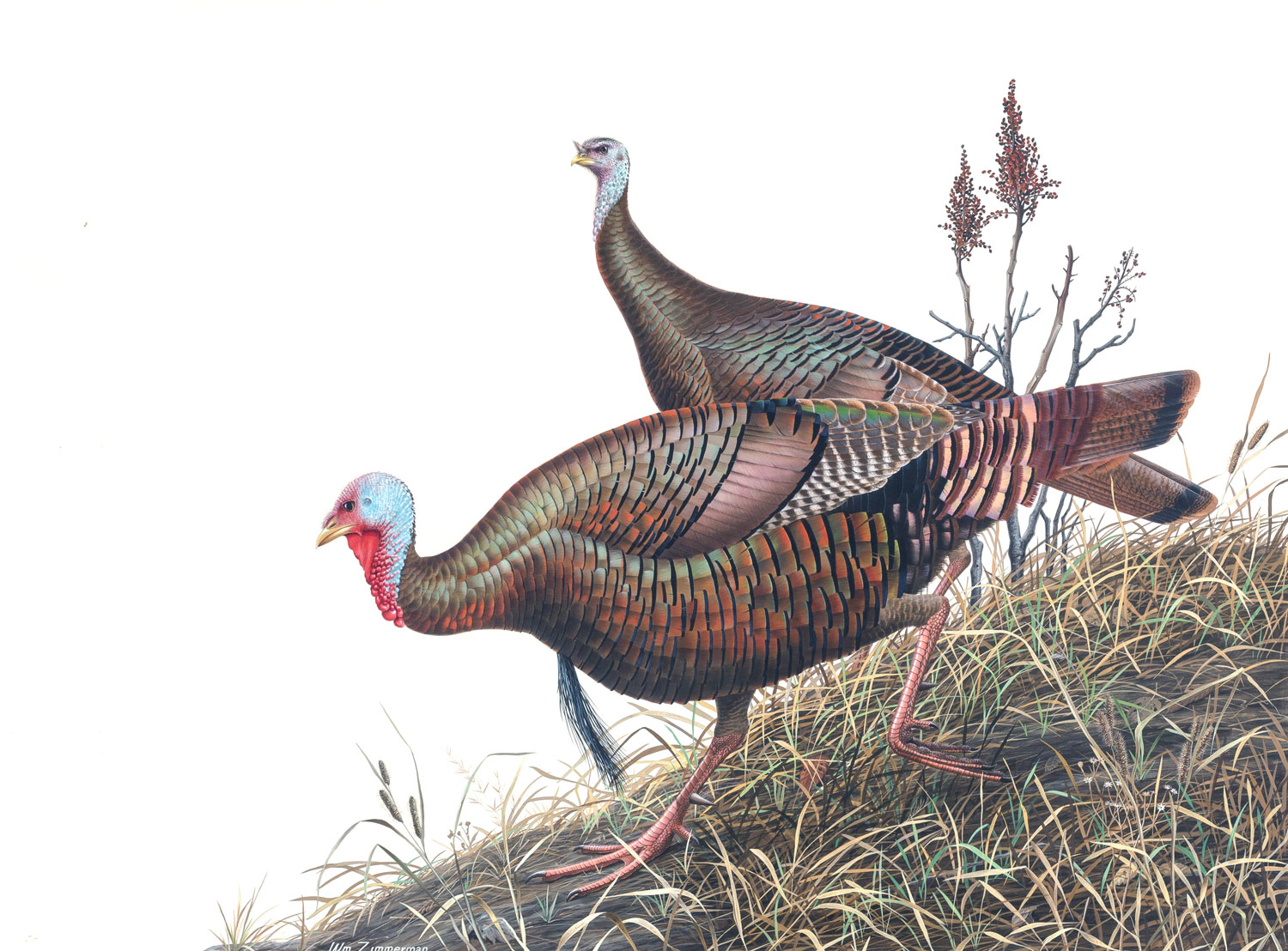
Two Turkeys by William Harold Zimmerman (American, b. 1937). Watercolor and gouache, 28 x 38 inches.
In an afternoon hunt on the lands of a club to which I belonged, I got a turkey fired up and he came to the call in the straightforward fashion every hunter wishes for, but rarely experiences. I saw him at 100 yards, got my gun up when he went behind a tree, and had already selected the spot where I would take the shot if he continued on his direct path toward me. On he came, and when he was perhaps 50 yards away, my finger slipped the safety off. The bird covered another 10 or 12 yards and I had already begun to squeeze the trigger when there was as loud a putt as I’ve ever heard and the gobbler took wing as if he had stepped in a bed of red-hot coals.
Shaken, dismayed and in disbelief, I tried to analyze what had transpired. Nothing made sense. My set-up had been first-rate with a huge root complex at my back to block my profile and a sheltering screen of switch canes in front of me. I knew I hadn’t made any untoward movement and simply was flummoxed. Finally, conducting the sort of analysis normally associated with successful hunts, I began stepping off the distance to where the bird took flight. At 34 yards the explanation became all too obvious. I all but stepped on a massive black snake—it would probably have measured a full six feet in length—and were humans capable of flight I’m sure I would have joined the gobbler in rapid departure from the scene. As it was, I all but levitated before recovering my senses. The black snake had saved the turkey’s life.
Sneaky Stuff
Fairly early on in my development as a turkey hunter, realization dawned that willingness to adjust tactics and techniques looms large in overall development of one’s skill set in the sport. Mind you, that learning process is an ongoing one, and when Archibald Rutledge reckoned, after having killed his 339th gobbler, that he might possibly have reached “the kindergarten stage,” he went to the heart the matter. It isn’t a sport you fully master, as I learned in perhaps my fifth or sixth season.
I enjoyed the undoubted advantage of having access to property where there were numerous turkeys that had faced little hunting pressure. After limiting out for several seasons in a row (and at the time you could annually tag five turkeys in South Carolina), I got to thinking I was a turkey-killing machine. That period of stupidity ended abruptly when a longbeard eased up behind a tree where I had set up and gave voice. I fortunately didn’t mess my camo overalls, but the experience left me a temporary mental wreck and to this day serves as a reminder about one’s skill level.
It also was an object lesson in the importance of constantly striving to improve because, for a masterful turkey hunter, graduation day never arrives. Instead, his is a delightful, never-ending quest to improve. Part of that process involves a flexible mindset and willingness to resort to unorthodoxy. Mine was the great good fortune, at the outset of my turkey hunting career, to be befriended by a highly skilled member of the old school of gobbler getters, Parker Whedon.

Wild Turkey, 1945, by Francis Lee Jaques, oil on canvas on masonite, 24 by 20 inches.
As was generally true for those who cut their turkey-hunting teeth in the era prior to the grand bird’s magnificent comeback saga, Parker was secretive and shepherded his hard-earned knowledge as he would have the key to a safe deposit box loaded with riches. Somehow though, he took a liking to me and, over time, imparted, bit by choice bit, decades of accumulated wisdom. Often this would come in the form of reaction to my latest tale of misery, missteps, mistakes, misfortune, misses or messes. He would chuckle at my latest chronicle of disaster and say something to the effect of “next time you might want to try this.”
One such suggestion involved dealing with gobblers in wide open areas that refused to leave a prime strutting area where they could see and be seen. He suggested, although solely as a desperation measure, a charge worthy of the “berserkers” who followed the Madhi and killed Chinese Gordon in a famed Victorian episode at Khartoum, deep in the heart of Africa.
I more or less dismissed Parker’s concept until the final day of what had been a frustrating season. I was dealing with a visible, “hung up” bird that was responsive, answering my every call, yet refusing to take so much as the first step toward my wood’s edge hiding spot. I repeatedly looked at my watch, since the time when I had to leave in order to be back for a class at the college campus where I taught was drawing ever closer. Finally, I recalled Parker’s thoughts on a “hunter charge” and reckoned that all other options were exhausted and my season effectively at an end.
Accordingly, I gathered myself and launched out across the clear cut at the best speed possible. Amazingly, the gobbler, rather than taking flight, squatted in place and stayed there until I stopped within gun range. At that point it was too late, and I headed to my truck and thence to the classroom toting a fine longbeard. Mind you, I’ve tried this desperation measure a half dozen times over the decades since this episode, and only on one other occasion did it work.
A Soaked Poacher
A late friend of mine was a first-class turkey hunter, but as I discovered, he had a periodic penchant to “stretch a fence,” as poaching is sometimes described in my part of the world. One cold spring morning (there was a smattering of frost) I met him well before daylight. He gave me a quick tutorial on the lay of the land before we headed in opposite directions. His last instruction, one offered with considerable emphasis, was “whatever you do don’t cross the creek. It’s the property line. You’ll hear turkeys on the opposite side, but don’t dare yield to temptation and go to them.
The landowner frowns on trespassing in the worst sort of way.”
I offered assurances to the effect that I would go forth and sin not, but at fly-down time temptation arrived in a serious fashion. Not one but several gobblers sang a hallelujah chorus across the stream, which was 15 to 20 feet wide and only a foot or so deep in most places. My reaction was to attempt to make the best of a bad situation. That involved setting up in a likely (and legal) location and doing my darndest to call a bird across the creek. As anyone who has done a good deal of turkey hunting knows, that’s not impossible, but it ranks well toward the top of the unlikely list.
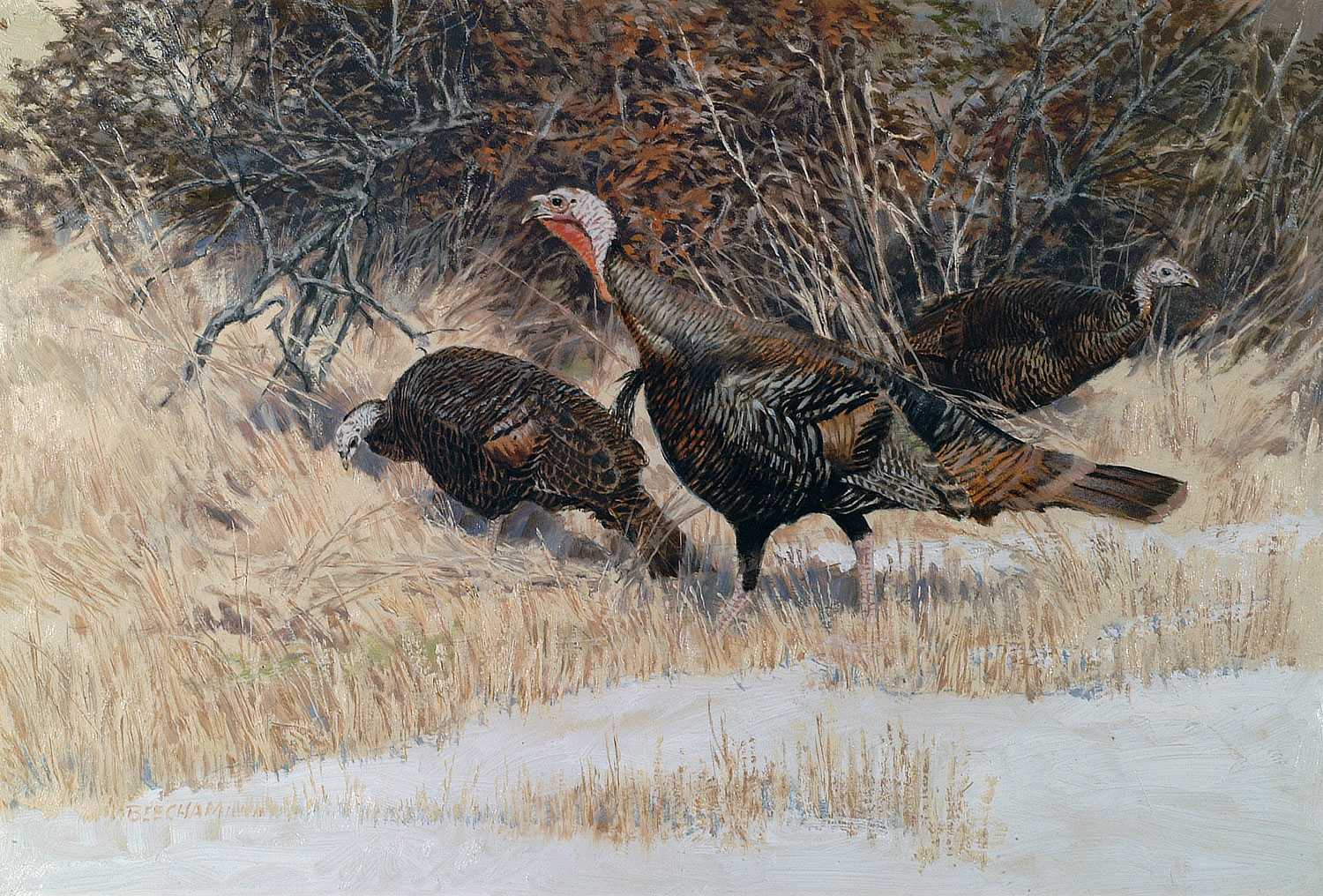
Wild Turkeys (detail), by Tom Beecham.
Still, I did get some interest and had three turkeys, two of them visible at 100 yards or so on the opposite side of the water course, putting on quite a show. With the turkey hunter’s often misplaced but ever present optimism, I sat hoping against hope one of them would fly to my side and then come within range. This went on for at least half an hour with a great deal of gobbling, plenty of excitement on my part, and no indication whatsoever that a bird was going to wing its way to legal ground.
Then suddenly there was a shot, a flopping turkey half struggling to its feet, and out of nowhere came a scampering hunter. He grabbed the turkey and, without breaking stride, hit the creek directly in front of me. The gobbler, which had plenty of life left in it, was resisting valiantly, and once the pair got in the water the bird performed the equivalent of a vigorous backstroke. It was able to do so because the hunter, in his inordinate haste to get to legal ground, had chosen what was quite possibly the only spot within a quarter of a mile where the creek had any depth—it came up to the hunter’s chest. About that point I realized that the poacher was my pal and, as he reached midstream with water and feathers flying, I shouted in the deepest voice I could muster, “That’s far enough. Drop that turkey and ease out of the creek!”
For a brief moment, before realization dawned, he attempted to follow instructions, although he dropped his shotgun rather than the flopping turkey. After he retrieved his shotgun, exhausted his extensive repertoire of curses, and managed to get out of wet clothing and approach a state involving at least some semblance of warmth, my buddy reflected on the error of his ways in hang jaw fashion.
“That will teach me,” he reckoned, “not to trespass but also not to trust you when the opportunity to pull my string arises.” Still laughing almost uncontrollably a quarter hour after the fact, I replied with something to the effect that it was a toss-up as to which looked worse—the drenched and finally deceased turkey or him.
Nature’s Call
All the experiences described above were special and memorable moments, but perhaps none remains as firmly embedded in the corridors of my mind as a morning that produced a remarkable double on gobblers. I had spent most of the morning listening to the sounds of silence, with not so much as a single gobble greeting my initial tree calls or, later, coverage of considerable ground in a cutt-and-run foray. Then, late in the morning, a biological urge seized me that demanded immediate attention.
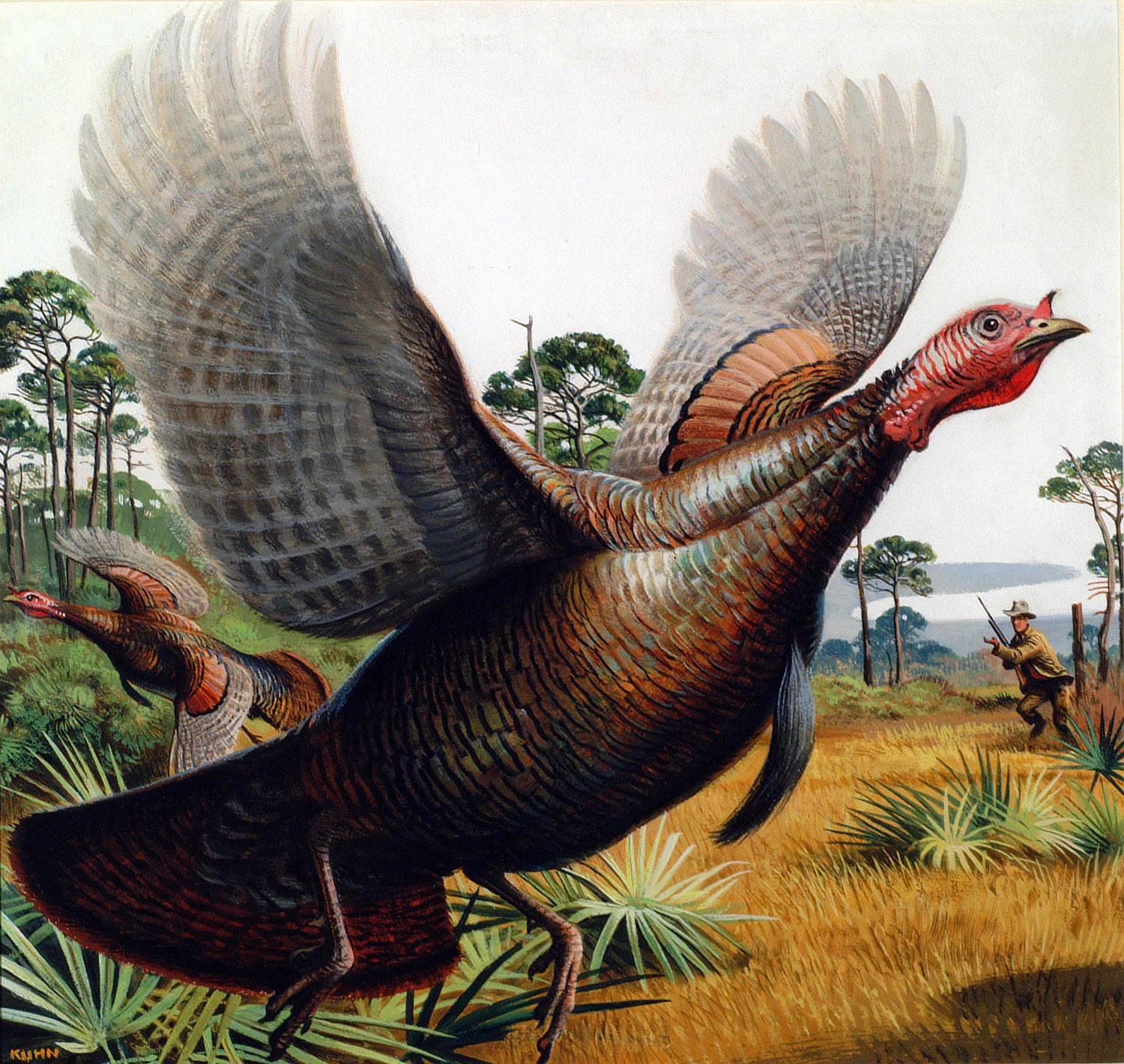
Wild Turkeys by Bob Kuhn.
I squatted on the spot, fished some toilet paper out of my vest and answered nature’s call. In the midst of doing my business, I heard footsteps in the leaves just across the top of a small ridge above me. Something told me to pick up my shotgun and no sooner had I done so than a red head popped up. The bird disappeared with my shot but flopping and a ruckus in the leaves convinced me I had killed the tom. However, as I started to pull my overalls up, I happened to look where I would be heading momentarily to retrieve my turkey. There stood a gobbler acting quite strangely. It repeatedly turned in circles, bobbing up and down, first in sight then out of my vision.
My interpretation of all this was that I must have shot high with just a pellet or two grazing the gobbler’s head and that it was coming back to its senses. Accordingly, I shot again and then hastened to the spot. Many veteran hunters will already know what had transpired. The first turkey to die had been the dominant bird of a pair of “running mates,” and when the subordinate saw his compatriot/rival down, instinct went into gear. Pouncing on a rival that had likely kicked his butt dozens of times during the spring mating ritual, the second gobbler seized the opportunity for retribution. Obviously his sweet revenge was short lived. I left the woods toting close to 40 pounds worth of bearded gentlemen.

